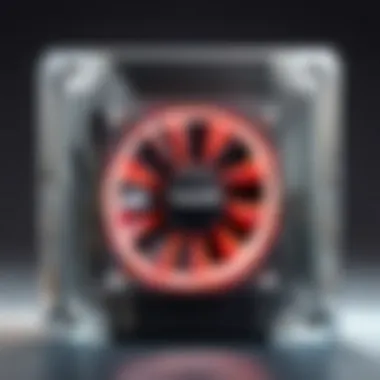Mastering CPU Performance: A Comprehensive Guide to Optimal Specs Selection


Game Overview
In the realm of computer hardware, the significance of selecting the best specifications for a CPU cannot be overstated. It is crucial for attaining optimal performance and efficiency in any computing system. This comprehensive guide aims to delve deep into the intricate details of CPU specifications, providing valuable insights and guidance to individuals looking to either build a new system or upgrade an existing one. From core count and clock speed to cache size and thermal design power, each aspect plays a pivotal role in determining the overall capability and effectiveness of a processor.
Introduction to CPU Specifications
When delving into the world of CPU specifications, one encounters a myriad of technical terms and jargon that can be overwhelming at first glance. However, by breaking down these specifications into digestible components, one can navigate the selection process with confidence and clarity. Core count refers to the number of processing cores within a CPU, affecting its multitasking abilities and overall speed. Clock speed, measured in gigahertz (GHz), determines how quickly the CPU can execute instructions. Cache size pertains to the on-chip memory that stores frequently accessed data, enhancing performance. Thermal design power (TDP) indicates the amount of heat the CPU generates and the cooling system it requires for optimal operation.
Significance of Each Specification
Understanding the significance of each CPU specification is vital in making informed decisions when selecting hardware for a system. The core count directly impacts the CPU's ability to handle multiple tasks simultaneously, making it crucial for users engaging in multitasking activities such as gaming, content creation, or data analysis. A higher clock speed results in faster processing speeds, ideal for tasks that require rapid data crunching and real-time responsiveness. A larger cache size provides quicker access to frequently used data, reducing latency and enhancing overall performance. Moreover, the thermal design power specification influences the cooling solutions required to maintain the CPU's temperature within optimal limits, preventing thermal throttling and ensuring consistent performance levels.
Conclusion
Understanding CPU Basics
In the intricate world of computer hardware, grasping the fundamental aspects of a CPU is akin to unlocking a treasure trove of performance potential. Understanding CPU basics delves into the heart of processor functionality, shedding light on core count, clock speed, cache size, and thermal design power. These elements form the backbone of CPU specifications, dictating the efficiency and capability of the processor. Embracing the nuances of CPU basics empowers users to make informed decisions when building or upgrading their systems.
Core Count
Significance of Core Count in CPU Performance
Delving into the significance of core count unveils the essence of processing prowess within a CPU. The core count essentially determines the number of independent processing units within the processor, akin to a team of workers collaborating on various tasks simultaneously. A higher core count translates to enhanced multitasking capabilities, enabling seamless execution of multiple operations concurrently. This aspect is particularly valuable in scenarios where demanding tasks or applications necessitate efficient resource allocation across various cores. Despite the undeniable benefits, the choice of core count must align with individual user requirements, balancing performance needs with affordability and practicality.
Multitasking Capabilities
Exploring the multitasking capabilities of CPUs illuminates the convenience and efficiency facilitated by a higher core count. The ability to juggle disparate tasks seamlessly is a coveted feature for users engaging in diverse activities, such as gaming, content creation, or professional applications. Superior multitasking prowess not only accelerates task completion but also optimizes system resource utilization, contributing to a smoother and more responsive computing experience. However, it is imperative to weigh the advantages of multitasking capabilities against the associated costs, ensuring a judicious investment that aligns with the intended usage and performance expectations.
Clock Speed
Impact of Clock Speed on Processing Speed
Unveiling the impact of clock speed on processing speed unveils the intricate dance between computational velocity and operational efficiency. The clock speed of a CPU denotes the frequency at which the processor executes instructions, akin to the heartbeat of the system. A higher clock speed translates to swifter data processing and task execution, vital for demanding applications that necessitate rapid computational throughput. However, individuals must tread cautiously when pursuing heightened clock speeds, considering factors such as heat generation, power consumption, and system stability. Balancing the allure of speed with practical considerations is paramount to maximizing the performance benefits of clock speed optimization.
Overclocking Considerations
Embarking on the realm of overclocking considerations unveils a realm of untapped potential and inherent risks within a CPU. Overclocking involves pushing the processor beyond its factory-defined specifications to achieve heightened performance levels. This practice demands a delicate balance between performance gains and system stability, as excessive overclocking can lead to thermal issues, system instability, and potentially void warranties. Nevertheless, when executed judiciously, overclocking can unleash additional processing power, catering to users seeking to extract every ounce of performance from their hardware platform.


Cache Size
Cache Types and Functions
Revealing the intricacies of cache types and functions sheds light on a crucial component enhancing CPU performance. Caches act as high-speed memory buffers that store frequently accessed data and instructions, ensuring rapid retrieval and computation. The effectiveness of caches stems from their proximity to the processor, minimizing latency and optimizing data accessibility. Varied cache types cater to specific operational requirements, such as L1, L2, and L3 caches, each offering a unique balance of capacity and access speed. Leveraging the optimal cache type aligns with individual workload demands, streamlining data processing and augmenting overall system responsiveness.
Effects of Cache Size on Performance
Unraveling the effects of cache size on performance elucidates the intricate relationship between data availability and processing efficiency. The cache size directly influences the volume of data that can be stored close to the processor, impacting the frequency of costly memory accesses. A larger cache size enhances data locality, minimizing the need to fetch data from slower system memory, thus expediting processing speeds. However, users must navigate the trade-offs associated with cache size, considering factors such as cost, power consumption, and compatibility with workload requirements. Striking a harmonious balance between cache size and operational demands is crucial to optimizing system performance.
Thermal Design Power (TDP)
Understanding TDP in CPU Specifications
Deciphering the significance of thermal design power (TDP) in CPU specifications unveils the thermal constraints and cooling demands of processors. TDP denotes the maximum amount of heat generated by a CPU under typical workloads, guiding users in selecting appropriate cooling solutions to maintain optimal operating temperatures. Understanding the TDP rating of a processor aids in configuring thermal management strategies, preventing overheating and ensuring long-term system stability. Different TDP ratings cater to varying performance tiers, offering users the flexibility to align thermal characteristics with their computing needs.
Cooling Solutions for Different TDP Ratings
Exploring the realm of cooling solutions for different TDP ratings unravels a diverse landscape of thermal management options optimized for varying processor demands. Air cooling and liquid cooling stand as predominant solutions, each offering distinct advantages in terms of cost, installation complexity, and thermal dissipation efficiency. Users must meticulously match cooling solutions with the TDP rating of their CPU, ensuring effective heat dissipation and system longevity. Moreover, considerations such as system airflow, case design, and thermal interface materials play pivotal roles in enhancing the efficacy of cooling solutions, warranting a holistic approach to thermal management.
This section encapsulates a detailed exploration of optimizing CPU performance, shedding light on critical factors such as core count, clock speed, cache size, and thermal design power. By unraveling the intricate interplay between these elements, users gain a comprehensive understanding of CPU specifications, enabling informed decisions and meticulous system optimization strategies.
Choosing the Right CPU for Your Needs
Selecting the right CPU is a critical decision when optimizing system performance. When choosing a CPU, several factors must be considered to ensure it aligns with your specific requirements. Whether you prioritize gaming, content creation, or professional applications, selecting a CPU that can handle your workload efficiently is paramount. Budget considerations play a significant role in this decision-making process, as balancing performance and price is crucial to achieving value for money.
Budget Considerations
Balancing Performance and Price
Balancing performance and price is a delicate act that involves maximizing processing power while staying within budget constraints. It is essential to find a CPU that offers the best performance for the price point, ensuring that you get the most out of your investment. By striking a balance between performance capabilities and cost-effectiveness, you can create a system that meets your needs without overspending. However, it is important to weigh the trade-offs carefully, as focusing solely on price may compromise performance.
Value for Money
Value for money is a key consideration when choosing a CPU. It involves assessing the overall benefits a processor offers in relation to its cost. Opting for a CPU that provides a high level of performance relative to its price tag ensures that you are making a sound investment. While it is tempting to go for the most expensive option, evaluating whether the features and performance justify the cost is crucial. Value for money ensures that you are getting the best possible performance within your budget constraints, maximizing the efficiency and effectiveness of your system.
Usage Scenarios


Gaming
For gaming enthusiasts, the CPU plays a vital role in ensuring smooth gameplay and optimal performance. Gaming places high demands on a processor, requiring fast clock speeds and multiple cores to handle complex calculations seamlessly. When selecting a CPU for gaming, it is important to consider factors such as single-core performance, multitasking capabilities, and overclocking potential to enhance gaming experiences.
Content Creation
Content creation tasks such as video editing, graphic design, and 3D rendering require a CPU with multitasking prowess and high processing power. Choosing a CPU tailored to content creation ensures faster rendering times, smoother workflow, and enhanced performance in resource-intensive applications. Opting for a processor with high core counts, ample cache sizes, and efficient thermal design ensures that content creators can work efficiently without bottlenecks.
Professional Applications
Professionals relying on CPU-intensive applications such as data analysis, engineering simulations, and software development require a CPU that can handle complex computations with ease. Selecting a CPU optimized for professional applications involves identifying processors with high core counts, enhanced cache sizes, and compatibility with specialized software. By choosing a CPU that aligns with professional needs, users can improve productivity, reduce processing times, and enhance overall workflow efficiency.
Compatibility
Socket Type
The socket type of a CPU determines its physical compatibility with the motherboard. Matching the correct socket type ensures that the processor fits securely in the motherboard, allowing for proper communication between the CPU and other components. Socket types vary between CPU generations and manufacturers, so selecting a CPU with a compatible socket type is essential for successful system assembly. By considering the socket type, users can avoid compatibility issues and ensure a seamless building or upgrading process.
Chipset Support
Chipset support is another crucial aspect to consider when choosing a CPU. The chipset of a motherboard dictates the features, connections, and performance capabilities of the system. Ensuring that the CPU is compatible with the motherboard's chipset guarantees optimal functionality and performance. By selecting a CPU with the correct chipset support, users can maximize system efficiency, utilize advanced features, and ensure smooth operation across all components. Compatibility between the CPU and chipset is integral to achieving peak performance and system stability.
Optimizing CPU Performance
In the world of computer hardware, optimizing CPU performance is a critical aspect that can significantly impact the overall efficiency and speed of a system. When delving into the intricacies of CPU performance optimization, there are specific elements that one must consider to ensure the best possible outcome. Factors such as cooling solutions, overclocking potential, and monitoring and maintenance all play a vital role in achieving peak performance from your CPU.
Cooling Solutions
Air Cooling vs. Liquid Cooling
When it comes to cooling solutions for CPUs, the debate between air cooling and liquid cooling has been ongoing. Air cooling, relying on heatsinks and fans, is a traditional and cost-effective method of dissipating heat from the CPU. On the other hand, liquid cooling systems leverage a coolant-filled loop to efficiently remove heat, offering better thermal performance in some scenarios. The choice between air and liquid cooling ultimately depends on the specific requirements of the user and the cooling efficiency needed for the CPU.
Factors Influencing Cooling Efficiency
Various factors can influence the efficiency of CPU cooling solutions. From the design of the heatsink and fan configuration to the airflow within the computer case, every component plays a crucial role in maintaining optimal temperatures. Ensuring proper ventilation, dust management, and thermal paste application are essential considerations to enhance cooling efficiency. Balancing these factors correctly can lead to improved overall system performance and longevity.
Overclocking Potential


Overclocking, the practice of increasing a CPU's clock speed beyond its factory settings, can offer a performance boost for users seeking additional power. By maximizing the CPU potential through overclocking, individuals can experience faster processing speeds and better overall system responsiveness. However, overclocking comes with its own set of risks, including increased heat generation and potential hardware damage. It is crucial to weigh the benefits of overclocking against the associated risks before attempting to push your CPU beyond its limits.
Maximizing CPU Potential
To maximize the CPU potential through overclocking, users can adjust the clock speed and voltage settings in the BIOS or through overclocking software. By carefully monitoring temperature levels and stress testing the system, users can find the optimal balance between performance gains and system stability. Understanding the capabilities of your CPU and the limitations of your cooling solution is key to successfully overclocking your processor.
Risks and Benefits of Overclocking
While overclocking can provide a performance boost, it also presents certain risks that users should be aware of. Increased power consumption, heat output, and decreased hardware lifespan are common concerns associated with overclocking. On the other hand, the benefits of overclocking include potential performance gains in CPU-intensive tasks such as gaming and content creation. It is essential to approach overclocking with caution and implement proper cooling and monitoring measures to mitigate any adverse effects.
Monitoring and Maintenance
Monitoring the temperature and overall health of your CPU is essential for ensuring long-term performance and reliability. Utilizing temperature monitoring tools allows users to track CPU temperatures in real-time and identify any potential issues that may affect performance. Additionally, regular cleaning and maintenance procedures, such as removing dust buildup and applying new thermal paste, can optimize the efficiency of your cooling solution and prolong the lifespan of your CPU.
Temperature Monitoring Tools
Temperature monitoring tools provide users with valuable insights into the thermal performance of their CPU. By tracking temperature trends under different workloads, users can adjust their cooling solutions and overclocking settings for optimal performance. Investing in high-quality temperature monitoring software or hardware can help users maintain a stable and efficient system temperature, preventing thermal throttling and performance degradation.
Cleaning and Care Procedures
Proper cleaning and care procedures are essential for maintaining the longevity and performance of your CPU. Regularly cleaning dust accumulation from heatsinks, fans, and air vents prevents airflow blockages and helps dissipate heat effectively. When performing maintenance tasks, such as applying new thermal paste or reseating the CPU cooler, users should follow manufacturer guidelines to avoid damaging the CPU or other components. By incorporating regular maintenance into your system care routine, you can ensure that your CPU operates at peak performance levels for years to come.
Future Developments in CPU Technology
When it comes to Future Developments in CPU Technology, it's imperative to stay abreast of the latest advancements shaping the landscape of computing. Understanding the trajectory of CPU innovation can significantly influence decision-making when choosing hardware components. Envisioning the forthcoming technologies can provide insights into potential performance enhancements, efficiency gains, and new capabilities that may redefine the computing experience.
Emerging Trends
Quantum Computing
Quantum Computing represents a paradigm shift in computational power, leveraging the principles of quantum mechanics to perform complex calculations at an exponential pace. The distinctive characteristic of Quantum Computing lies in its utilization of qubits, which can exist in multiple states simultaneously, enabling the processing of vast amounts of information swiftly. In this context, Quantum Computing stands out for its unparalleled processing speed and the ability to solve problems that are currently infeasible for classical computers. While Quantum Computing offers unparalleled computational power, challenges exist in scaling up these systems for practical applications due to factors like stability and error correction mechanisms.
AI Integration
AI Integration entails embedding artificial intelligence algorithms into CPU architectures to enhance predictive capabilities, automation, and decision-making processes. The key feature of AI Integration is its capacity to streamline tasks, improve efficiency, and adapt to dynamic computing requirements. By integrating AI into CPUs, performance gains can be realized through optimized resource allocation, task prioritization, and adaptive learning mechanisms. However, the integration of AI poses challenges related to data privacy, algorithm bias, and the ethical implications of autonomous decision-making in critical applications.
Impact on Consumer Hardware
Enhanced Performance
Enhanced Performance in CPU technologies signifies the continuous optimization of processing capabilities, energy efficiency, and multitasking prowess. The pivotal aspect of Enhanced Performance lies in its ability to deliver faster processing speeds, smoother multitasking experiences, and enhanced graphics rendering for immersive computing experiences. By implementing advanced technologies such as multi-core processing, hyper-threading, and dynamic overclocking, CPUs can elevate overall system performance while maintaining thermal efficiency.
Adaptation Challenges
Adaptation Challenges encompass the hurdles faced by consumers in integrating cutting-edge CPU technologies into existing hardware ecosystems seamlessly. The critical characteristic of Adaptation Challenges is their influence on upgrade compatibility, software optimization, and system stability. Consumers may encounter obstacles such as socket incompatibility, firmware updates, and driver dependencies when transitioning to newer CPU architectures. Mitigating Adaptation Challenges involves thorough research, firmware updates, and hardware compatibility checks to ensure a smooth transition without compromising system integrity.



